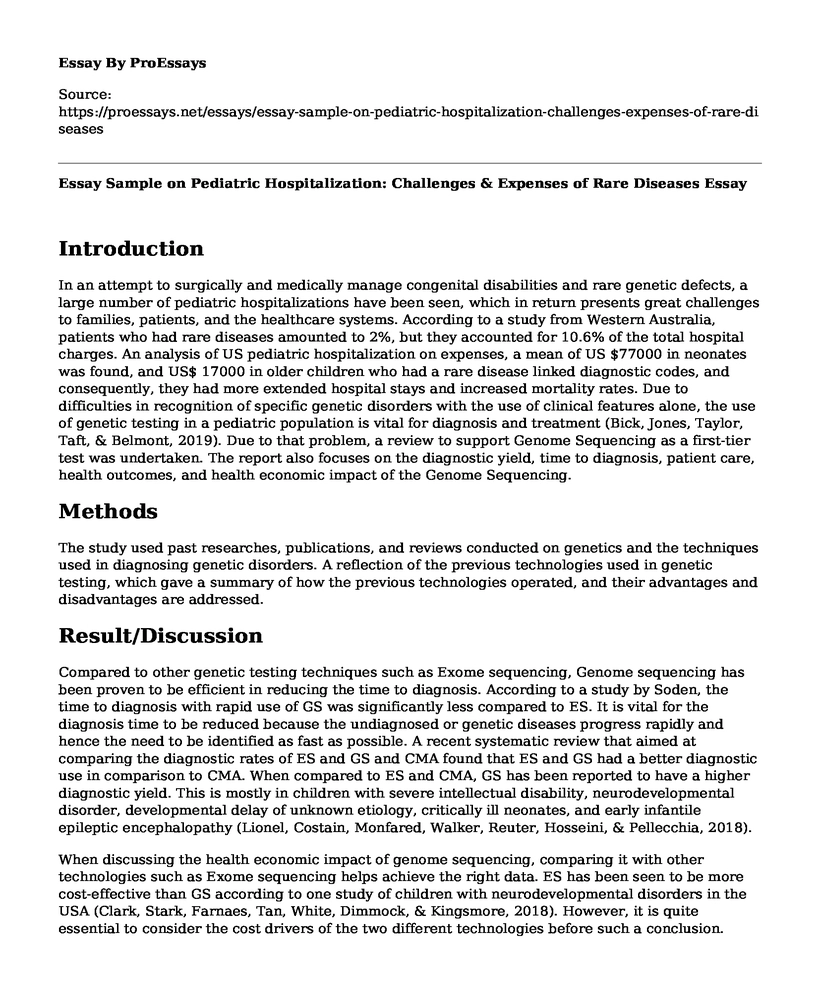Introduction
In an attempt to surgically and medically manage congenital disabilities and rare genetic defects, a large number of pediatric hospitalizations have been seen, which in return presents great challenges to families, patients, and the healthcare systems. According to a study from Western Australia, patients who had rare diseases amounted to 2%, but they accounted for 10.6% of the total hospital charges. An analysis of US pediatric hospitalization on expenses, a mean of US $77000 in neonates was found, and US$ 17000 in older children who had a rare disease linked diagnostic codes, and consequently, they had more extended hospital stays and increased mortality rates. Due to difficulties in recognition of specific genetic disorders with the use of clinical features alone, the use of genetic testing in a pediatric population is vital for diagnosis and treatment (Bick, Jones, Taylor, Taft, & Belmont, 2019). Due to that problem, a review to support Genome Sequencing as a first-tier test was undertaken. The report also focuses on the diagnostic yield, time to diagnosis, patient care, health outcomes, and health economic impact of the Genome Sequencing.
Methods
The study used past researches, publications, and reviews conducted on genetics and the techniques used in diagnosing genetic disorders. A reflection of the previous technologies used in genetic testing, which gave a summary of how the previous technologies operated, and their advantages and disadvantages are addressed.
Result/Discussion
Compared to other genetic testing techniques such as Exome sequencing, Genome sequencing has been proven to be efficient in reducing the time to diagnosis. According to a study by Soden, the time to diagnosis with rapid use of GS was significantly less compared to ES. It is vital for the diagnosis time to be reduced because the undiagnosed or genetic diseases progress rapidly and hence the need to be identified as fast as possible. A recent systematic review that aimed at comparing the diagnostic rates of ES and GS and CMA found that ES and GS had a better diagnostic use in comparison to CMA. When compared to ES and CMA, GS has been reported to have a higher diagnostic yield. This is mostly in children with severe intellectual disability, neurodevelopmental disorder, developmental delay of unknown etiology, critically ill neonates, and early infantile epileptic encephalopathy (Lionel, Costain, Monfared, Walker, Reuter, Hosseini, & Pellecchia, 2018).
When discussing the health economic impact of genome sequencing, comparing it with other technologies such as Exome sequencing helps achieve the right data. ES has been seen to be more cost-effective than GS according to one study of children with neurodevelopmental disorders in the USA (Clark, Stark, Farnaes, Tan, White, Dimmock, & Kingsmore, 2018). However, it is quite essential to consider the cost drivers of the two different technologies before such a conclusion. More than 90% of the costs of GS are directly linked to sequencing, while the costs of ES are related to DNA capture essay and associated labor. However, over time, the costs of sequencing have significantly reduced, thus making GS more health economic friendly.
Conclusion
The research provides valuable information on the use of GS as a first-tier rather than a last resort technique as it will be of benefit to many populations, especially the critically ill neonates where rapid diagnosis is essential. Future researches should focus on exploring the presentations and diseases in which the use of rapid GS has the most diagnostic effectiveness.
References
Bick, D., Jones, M., Taylor, S. L., Taft, R. J., & Belmont, J. (2019).Case for genome sequencing in infants and children with rare, undiagnosed or genetic diseases.Journal of medical genetics, jmedgenet-2019.
Clark, M. M., Stark, Z., Farnaes, L., Tan, T. Y., White, S. M., Dimmock, D., & Kingsmore, S. F. (2018). Meta-analysis of the diagnostic and clinical utility of genome and exome sequencing and chromosomal microarray in children with suspected genetic diseases. NPJ genomic medicine, 3.
Lionel, A. C., Costain, G., Monfared, N., Walker, S., Reuter, M. S., Hosseini, S. M., ...& Pellecchia, G. (2018). Improved diagnostic yield compared with targeted gene sequencing panels suggests a role for whole-genome sequencing as a first-tier genetic test. Genetics in Medicine, 20(4), 435.
Cite this page
Essay Sample on Pediatric Hospitalization: Challenges & Expenses of Rare Diseases. (2023, Mar 12). Retrieved from https://proessays.net/essays/essay-sample-on-pediatric-hospitalization-challenges-expenses-of-rare-diseases
If you are the original author of this essay and no longer wish to have it published on the ProEssays website, please click below to request its removal:
- Course Work Example: Management in Health Care
- Statistics for the Behavioural Sciences Paper Example
- The Chronic Respiratory Health Effects That the Firefighters Are Exposed to Paper Example
- Smokers With COPD That Are Oxygen Dependent - Essay Sample
- Neurological Disorders: Alzheimer, Epilepsy, Parkinson's, Brain Tumors, Stroke, Migraine +more - Essay Sample
- Essay Example on Critiquing Research on Type 2 Diabetes and Ethics
- Sedation and Alternative Techniques in Helping Pediatric Patients During MR Imaging - Paper Sample







